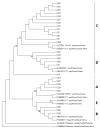Genetic Characterization of Piroplasms in Donkeys and Horses from Nigeria
- PMID: 32085574
- PMCID: PMC7070495
- DOI: 10.3390/ani10020324
Genetic Characterization of Piroplasms in Donkeys and Horses from Nigeria
Abstract
Equine piroplasmosis (EP) is a tick-borne disease of equids, caused by the two haemoprotozoal parasites: Theileria equi and Babesia caballi. Nigeria constitutes a major crossroads of animal transport in West Africa and may serve as a factor in EP dissemination in the region. The study aim was to characterize EP parasites in donkeys and horses in northern Nigeria using a molecular approach. Blood was collected from 57 donkeys and 47 horses. EP infection was detected and characterized by polymerase chain reaction (PCR). Twenty five donkeys (43.8%) were infected with T. equi, five (8.8%) with B. caballi, three (5.3%) with dual infections. Four horses (8.5%) were infected by T. equi and none by B. caballi. Four of the five known T. equi 18S rRNA genotypes (A, B, C and D) were identified. Theileria equi ema-1 and ema-2 genes were amplified in only 2 and 10 samples, respectively, showing no genetic variation. All B. caballi isolates were classified as rap-1 genotype A1. Twenty-two (42.3%) of the donkeys were positive for anti-T. equi antibodies and 29 (55.8%) were positive for anti-B. caballi antibodies, using immunofluorescence antibody test (IFAT). The study results demonstrate high genetic variation within T. equi parasites, suggesting that donkeys may be reservoirs of EP parasites in West Africa.
Keywords: Babesia caballi; Nigeria; Theileria equi; donkeys; horses.
Conflict of interest statement
The authors declare no conflict of interest.
Figures

Similar articles
-
Assessment of Theileria equi and Babesia caballi infections in equine populations in Egypt by molecular, serological and hematological approaches.Parasit Vectors. 2016 May 4;9:260. doi: 10.1186/s13071-016-1539-9. Parasit Vectors. 2016. PMID: 27146413 Free PMC article.
-
Seroprevalence of Theileria equi, Babesia caballi, and Trichinella spp. infections in horses and donkeys from Nigeria, West Africa.Trop Anim Health Prod. 2021 May 24;53(3):338. doi: 10.1007/s11250-021-02737-9. Trop Anim Health Prod. 2021. PMID: 34031761
-
Development and validation of a duplex real-time PCR assay for the diagnosis of equine piroplasmosis.Parasit Vectors. 2018 Mar 2;11(1):125. doi: 10.1186/s13071-018-2751-6. Parasit Vectors. 2018. PMID: 29499748 Free PMC article.
-
New insights in the diagnosis and treatment of equine piroplasmosis: pitfalls, idiosyncrasies, and myths.Front Vet Sci. 2024 Aug 14;11:1459989. doi: 10.3389/fvets.2024.1459989. eCollection 2024. Front Vet Sci. 2024. PMID: 39205808 Free PMC article. Review.
-
Review of equine piroplasmosis.J Vet Intern Med. 2013 Nov-Dec;27(6):1334-46. doi: 10.1111/jvim.12168. Epub 2013 Aug 28. J Vet Intern Med. 2013. PMID: 24033559 Review.
Cited by
-
Molecular and Serological Detection of Piroplasms in Horses from Nigeria.Pathogens. 2021 Apr 23;10(5):508. doi: 10.3390/pathogens10050508. Pathogens. 2021. PMID: 33922468 Free PMC article.
-
Equine piroplasmosis: an insight into global exposure of equids from 1990 to 2019 by systematic review and meta-analysis.Parasitology. 2020 Nov;147(13):1411-1424. doi: 10.1017/S0031182020001407. Epub 2020 Aug 3. Parasitology. 2020. PMID: 32741382 Free PMC article.
-
Revisiting the genotypes of Theileria equi based on the V4 hypervariable region of the 18S rRNA gene.Front Vet Sci. 2024 Mar 15;11:1303090. doi: 10.3389/fvets.2024.1303090. eCollection 2024. Front Vet Sci. 2024. PMID: 38560630 Free PMC article.
-
Tick-Borne Diseases of Humans and Animals in West Africa.Pathogens. 2023 Oct 24;12(11):1276. doi: 10.3390/pathogens12111276. Pathogens. 2023. PMID: 38003741 Free PMC article. Review.
-
Parasite load and genotype are associated with clinical outcome of piroplasm-infected equines in Israel.Parasit Vectors. 2020 May 20;13(1):267. doi: 10.1186/s13071-020-04133-y. Parasit Vectors. 2020. PMID: 32434550 Free PMC article.
References
-
- Rothschild C.M. Equine piroplasmosis. J. Equine Vet. Sci. 2013;33:497–508. doi: 10.1016/j.jevs.2013.03.189. - DOI
-
- Margalit Levi M., Tirosh-Levy S., Dahan R., Berlin D., Steinman A., Edery N., Savitski I., Lebovich B., Knowles D., Suarez C.E., et al. First Detection of Diffuse and Cerebral Theileria equi Infection in Neonatal Filly. J. Equine Vet. Sci. 2018;60:23–28. doi: 10.1016/j.jevs.2017.10.016. - DOI
LinkOut - more resources
Full Text Sources
Research Materials

